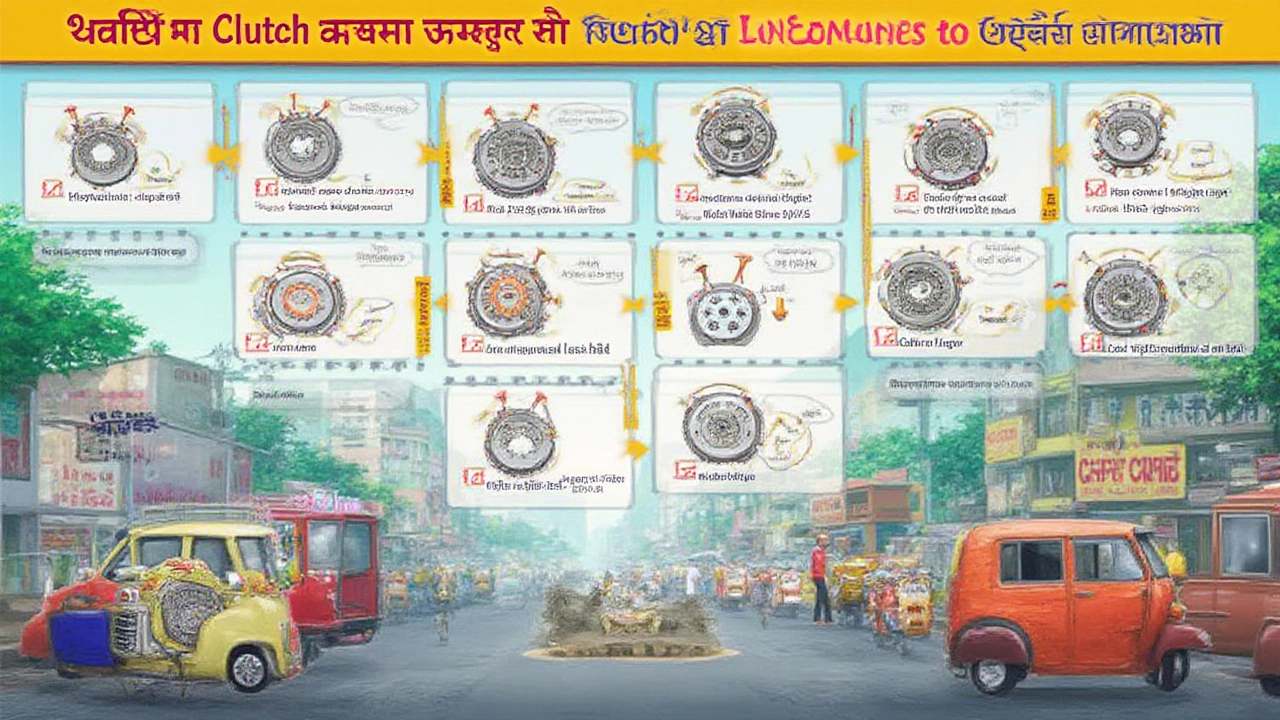Full Clutch Kit: Complete Guide to What’s Included and Why It Matters
 Jul, 5 2025
Jul, 5 2025
Ever had that moment where your foot presses the clutch and something feels, well, off? That weird grinding noise, the pedal that just won’t rebound, or the moment your car refuses to shift smoothly. That’s when the clutch gremlins come alive, and trust me—they don’t go away on their own. When you dig into what fixes those clutch nightmares, you almost always run into one phrase: a “full clutch kit.” But what’s actually in the box? And why does getting a complete kit matter instead of swapping out just one piece? Let’s break it all down—the good, the gritty, and even the surprisingly clever engineering hiding under your hood.
Main Components in a Full Clutch Kit
Pop open a full clutch kit and you’ll see more than just one metal disc. The star of the show is usually the clutch disc itself. It’s the pancake-shaped part sandwiched between the engine’s flywheel and the pressure plate. It handles the real business of transferring power—and it sees a lot of wear, which makes sense considering every takeoff, every gear shift, and even just sitting at stoplights puts it to work.
Up next, you’ll have the pressure plate. This heavy-duty spring-loaded cover bolts to the flywheel. It squeezes the clutch disc tight against the flywheel when your foot leaves the pedal. No tight squeeze means your car won’t go anywhere, and a worn pressure plate will have you grinding gears in frustration.
The flywheel is sometimes included, especially in premium or performance kits, but not always. Flywheels store and release energy from the engine and give a smooth, continuous motion. When they get heat-checked or cracked, things start shaking—literally and metaphorically. Performance drivers sometimes upgrade to lightweight flywheels to shave fractions of a second off their acceleration.
Don’t forget the release bearing (or throw-out bearing)—that’s the little part that gets crushed every time you press the clutch pedal. Its job is to disengage the pressure plate, so if it fails, you’ll notice whining, rattling, or a pedal that won’t behave.
Last but never least, there’s the pilot bearing or bushing. It sits at the very center of the flywheel and supports the transmission’s input shaft. A failing pilot bearing creates annoying noises and can cause rough shifting. Many clutch kits toss in an alignment tool as well, making it far easier to get that clutch disc perfectly centered when you’re putting everything back together.
Why You Should Choose a Complete Kit Instead of Piecemeal Repairs
If you ever worked on cars—or even watched a mechanic’s bill climb with each added part—you might wonder, “Why not just swap out the one part that’s broken?” Here’s the deal: the clutch works as a team. If you replace just the worn-out clutch disc and leave an old pressure plate, that weakened plate can quickly wear down the fresh disc. Same goes for a bad release bearing. Suddenly you’re right back where you started, just poorer and more frustrated.
Another thing—labor isn’t cheap. Mechanics have to remove the transmission from the engine to replace your clutch, and that’s a chore no one wants to do twice in a year. Nabbing a full clutch kit means you’re swapping all the important pieces in one go, and you’re far less likely to have to repeat the whole teardown anytime soon.
Even if you do your own wrenching, having every matching part in one box just makes life easier. You know it all fits, the wear surfaces are fresh, and there’s a sort of odd satisfaction seeing every single part gleam and click together just right.
On top of this, most warranty policies from reputable brands like Exedy or LuK only back their kits if all the included components were installed together. Stretched or mismatched parts can void your warranty. Newer clutch materials, like carbon or ceramic on high-performance models, are also usually designed to work with matching pressure plates. Swapping one but not the other? You’re risking some nasty surprises.

Typical Parts List—What’s Actually in the Box?
You want to know exactly what you’re paying for. Here’s a breakdown—sometimes with extras that vary by car model or brand, but these are the all-stars:
- Clutch Disc: The friction sandwich. Usually built with organic or sometimes performance ceramics for longer life.
- Pressure Plate: The muscle that holds everything tightly together. Comes as a cover with built-in springs.
- Release Bearing: Makes sure things disengage smoothly when you stomp the clutch.
- Pilot Bearing or Bushing: The supporting actor, but crucial for smooth operation.
- Alignment Tool: A cheap little plastic rod that saves hours of cursing during installation.
- Sometimes Flywheel: Usually in high-performance or dual-mass setups.
- Hardware: Alignment pins, bolts, and sometimes grease packets for the input shaft or splines.
The stuff in your box depends on make and model. For example, many Volkswagen kits use a dual-mass flywheel system for smoother operation, and those kits often swap the whole unit in one go because damage can transfer from disc to flywheel fast. Meanwhile, your typical Honda or Toyota might stick with tried-and-true single-mass flywheels, so the kit’s a little slimmer.
Ever wondered what materials go into a clutch? Most everyday vehicles stick to organic materials (like fiberglass or Kevlar blends) on their clutch discs for easy street driving. Truck and performance kits often go aggressive—diving into metallic or multi-puck ceramic discs for more bite but a lot less forgiveness in stop-and-go traffic. If your car’s clutch pedal feels like a gym workout, you might have a heavy-duty performance clutch hiding underfoot.
Installation Tips and Pro Insights
Tackling a clutch swap yourself? Get ready for some muscle and patience. Lifting a transmission out of a car, even with basic tools, is an upper-body workout and not for the impatient. Before you start, always check if your kit includes an alignment tool—it could save hours of headache trying to line up the disc on reassembly.
When you get the transmission down, inspect that flywheel! If there are any scorch marks, cracks, or excessive grooves, it’s time to resurface or outright replace it. Even if your clutch kit didn't come with a new flywheel, you don’t want to bolt up a fresh disc to a damaged surface. It’ll bite you back fast.
Use the included grease but sparingly. A little on the splines and the input shaft goes a long way. Too much can fling onto the clutch disc itself, causing annoying slips and squeals.
Replacing the pilot and release bearings is a must. These wear just as quickly as the clutch disc, and skipping them can cause noise, vibration, and poor shifting almost right away after your "new" clutch goes in. If you’ve ever wondered why some cars develop a weird screech soon after a clutch job—that’s usually a missed bearing swap.
One interesting fact: studies from industry leader Sachs show that most premature clutch failures after replacement are tied to not installing all new components. That means skipping one part could actually cost you more money and downtime in the end.
If you notice gear shifting is still notchy after installation, double-check your hydraulic clutch fluid. Low or old clutch fluid makes even the best new kit feel off.

Interesting Facts, Data, and Clutch Kit Comparison
It’s wild when you look at the numbers: according to a 2023 market study by Technavio, the global clutch kit market is expected to grow by $2.16 billion between 2021 and 2026, driven by higher demand from manual transmission cars in Asia and Latin America. Meanwhile, warranty data from exedyusa.com shows that full kits have a 35% lower comeback rate versus partial or piecemeal repairs.
Let’s throw a few practical comparisons into the mix. Check this mini-table for what to expect from various kit types and brands:
| Kit Brand | Disc Material | Included Flywheel | Performance Level |
|---|---|---|---|
| Exedy OE | Organic | No | Stock / Comfort |
| LuK RepSet | Organic or Kevlar | No | Stock or Slight Upgrade |
| ACT Heavy Duty | Ceramic / Metallic | Optional | Performance / Racing |
| Sachs Performance | Organic | Optional | Fast Street/Track |
If you’re driving a daily Civic or Corolla, an OE-style kit will do the trick for another 80,000-100,000 miles as long as you drive sensibly. But if you love downshifting aggressively, hunt for something built for performance—just be ready for a stiffer pedal and more frequent servicing.
Here are a couple of extra tips: always double-check your car’s specific fitment, especially if it’s been modified. Manufacturers sometimes make mid-year changes, and something as small as the wrong spline count on a disc can turn a half-day DIY job into a week of frustration. Watch for counterfeits, especially online—if the price seems too good to be true, it probably is. Sticking to trusted brands keeps your drivetrain safe and your wallet intact.
Regular clutch maintenance is often ignored, but it makes a huge difference. Get into the habit of not “riding” the clutch (resting your foot on the pedal), and whenever possible, shift smoothly without launching the car hard from every stoplight. The best clutch kits in the world can’t protect you from bad driving habits.
So, next time your car feels cranky or starts playing hard to shift, remember—there’s a reason experienced mechanics always recommend a full clutch kit. It’s about peace of mind, reliability, and knowing you won’t be back under the car again anytime soon. Missing one piece can put everything out of balance. Kits are built to work as whole systems, not solo acts.